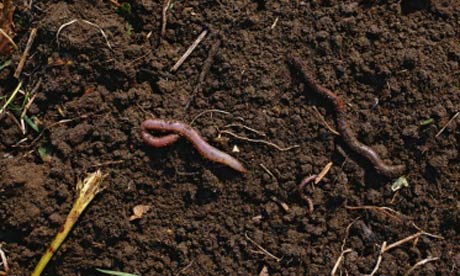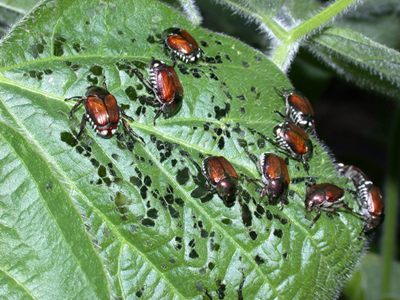This article is based on a workshop given at La Ruche
d’Art St-Henri (go check it out if you live in the neighborhood) in 2013.
The workshop was built around the philosophy that pest management is not about
killing insects, but rather knowing the different insects that can end up in
your garden and managing the garden itself in consideration of those insects
and what they might bring you (benefits, chaos and destruction, nothing, etc.).
Hygiene
Hygiene is important to prevent the spread of diseases from plant to plant,
as well as to prevent attracting more pests. It is a measure of prevention.
 |
| awaytogarden.com |
For all types of garden, tools (scissors,
knives, etc.) must be cleaned and sprayed with a 70%
alcohol solution (rubbing alcohol) before being used. Hands must also be washed if a diseased plant has
been touched.
Growing conditions
Also a measure of prevention. Good growing conditions allow the plants to
become and stay strong and healthy, which is essential for them in order to
fight pests and diseases, and also to improve resilience.
1- Good growing conditions can mean placing
the right plant at the right spot. This is where
finding information about the plants you grow gets useful, because it allows
you to know, for example, that a tomato plant will be much stronger and
healthier in a sunny spot than in the shade. It may be better to move a plant
that has not been placed at the correct spot in the middle of the season and
risk the transplanting shock than letting it grow weak at its original place,
where it will probably attract pest and catch diseases (both of which could
spread to other plants).
2- Another strategy is soil building and
fertilizing. Sick plants should not be fertilized, except if
using seaweed emulsion (supposedly it stimulates protein
synthesis and that’s pretty much the problem with sick plants). Normally, a good
potting mix will be 3 parts compost, 2 parts peat moss
and 1 part coco fiber (the latter two ingredients are not very eco-friendly,
though). Perlite (drainage), sand (drainage, finer grains) and vermiculite
(nutrient retention) can also be added, though it’s better to wear a mask
when using perlite and vermiculite, as they are
small, light pieces of rock and this is not too good for your lungs.
 |
| theguardian.com |
3- Crop rotation! By rotating crops, you make sure that it’s not always the same nutrients that are taken up from the soil at the same place from year to year. Plants have different needs and do not all take an equal amount of nitrogen, phosphorus or potassium (or trace minerals), so planting the same thing at the same place exhausts the soil faster than rotating crops. Here, knowing what was planted in a given location the preceding year, as well as knowing which plants got sick, is essential to plan crop rotation.
4- Pruning is a necessary but delicate
operation in a garden. Some diseases are easily contracted in badly aerated and
overcrowded conditions and pests are generally attracted by cuts, bruises or
wounds on a plant. Both diseases and pests also spread much more easily in
overcrowded conditions. Pruning can thus help aerate plants, prevent pests and
diseases, and hinder their propagation across the garden. But pruning, by
creating an open wound, also creates the conditions for developing diseases and
attracting pests, so it must be done in a way that reduces the likelihood for
those things to happen.
To prune properly, cut only the top third of a stalk (the third of the
length starting from the tip) or of the plant, in the case of naturally dense
plants like chives, in order to limit the expansion of the plant. For purposes
of aeration, whole stalks may be cut, and pruning in cases of damage to the
plant depends on where the damage has been done. If cutting can be done near a
budding region, make sure you cut close to the bud while leaving it intact on
the plant, as plants tend to naturally scar rapidly there. In any case, clean
and sterilized tools must be used (wipe out the alcohol before cutting, as it
would damage the plant), and pruning must be done at a 45° angle through the
stem (a beveled cut).
 |
| australiangeographic.com |
6- Companion planting. Companions can help a
plant get stronger, mask its odor from pests, attract predators, act as a trap
crop (so the pests attack this plant and not
another one), hide the plant from predators
(some beetles, for example, have very bad vision and can be confused by a wall
of bushy plants surrounding the plants that you want to protect), etc.. If
companion planting is not your cup of tea, consider letting a patch of your
garden go wild in order to attract all kinds of
insects (it could backfire as extra weeding for the following years, though).
Intervention
When hygiene and growing conditions have failed to prevent an infection,
it’s time to intervene. Intervention should occur AS SOON AS you see signs of
pests.
First thing to do, if there are few pest individuals and if you can see
them: squash them. With your hands. Or something. This may not work for pests
that are brought by other insects (e.g. ants farming aphids). You can keep to
this method as long as the situation is under control.
 |
| extension.entm.purdue.edu |
Do not spray seedlings! They’re not strong
enough and they’ll die.
Dusk might be the best time to spray, as a lot of beneficial predators are
inactive at the end of the day and there will be no risk to also hurt them when
spraying the pest.
Recipes
1- An alcohol spray can be used on soft-bodied insects (i.e. not beetles).
Here’s the recipe: 20mL dish soap + 15 mL 70% alcohol + 1 liter of water.
2- For molds (mildew), the spray recipe goes as such: 1-2g baking soda + 5 mL
dish soap + 1 L water. Molds will never go away with this spray, though, as the
spray only stops their growth and development. Diseased leaves should be
removed and burned (or at least not left anywhere near or in the garden, and
certainly not composted). The schedule is once a week or after a rain (and then
once a week starting from there). It’s important to spray both over and under
the leaves in a light mist without allowing droplets to form; droplets of this
spray could damage the plant and weaken them.
3- For hard-bodied insects, trap crops, finger squashing and companion
planting are the best strategies. Row covers can also be used but must be
installed before the insects come and be removed for plant maintenance only
when the pest is away doing something else (sleeping, reproducing, whatever).
4- For slugs and snails, attracting birds, installing beer traps, and
sprinkling calcium or diatomaceous earth (after every rain episode) can help.
5- For mammal pests, putting dog, cat or human hair, as well as using hunting
gear like deer scent, will normally deter raccoons, squirrels, cats, skunks and
other furry friends.
No comments:
Post a Comment